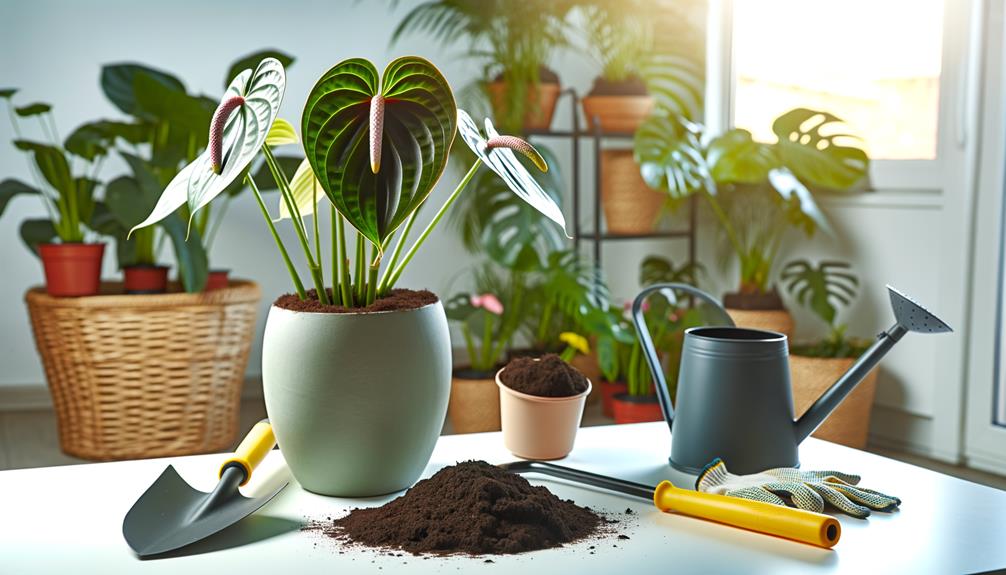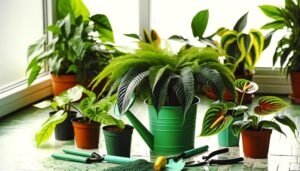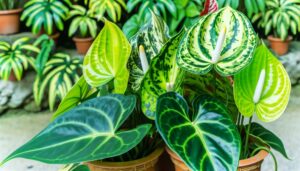How to Choose and Care for Anthurium Andreanum Hybriden
Selecting and caring for Anthurium andreanum hybrids starts with choosing the right variety for your environment and aesthetic preference. Opt for hybrids suited to your local humidity and temperature.
Place them in bright, indirect light and maintain temperatures between 70-85°F. Ensure soil is well-draining with a mix of orchid bark, perlite, and peat moss.
Water when the top inch of soil is dry, using distilled or rainwater. Fertilize with a balanced 20-20-20 fertilizer every 6-8 weeks, and trim dead leaves to encourage healthy growth.
Monitoring for pests and diseases is vital for plant health. There’s more to learn on optimal care practices.

Key Takeaways
- Select hybrids based on local humidity, temperature, and aesthetic preferences.
- Provide bright, indirect light for 10-12 hours daily to avoid leaf scorching.
- Maintain 70-85°F temperature and 70-80% humidity for optimal growth.
- Water when the top inch of soil is dry and ensure adequate drainage.
- Fertilize every 6-8 weeks with a balanced, diluted water-soluble fertilizer.
Understanding Anthurium Andreanum
Anthurium andreanum, commonly known as flamingo flower, is a tropical plant species renowned for its vibrant, heart-shaped spathes and glossy green leaves.
You’ll find this plant’s spathes in various colors, ranging from deep reds to pinks and whites. These spathes are actually modified leaves, or bracts, that support the inflorescence—a dense spike called a spadix.
The spadix is where the true flowers of the plant are found, tiny and densely packed. Anthurium andreanum thrives in humid conditions, requiring well-draining soil rich in organic matter.
To maintain ideal growth, you should provide indirect light and consistent moisture. This species’ unique morphology and adaptability make it an excellent choice for anyone seeking a touch of tropical elegance.
Choosing the Right Hybrid
When selecting an Anthurium andreanum hybrid, consider the specific environmental conditions and aesthetic preferences you aim to meet. Different hybrids exhibit variations in leaf morphology, inflorescence coloration, and growth habits.
Choose a hybrid that thrives in your local humidity levels and temperature range. For instance, some hybrids tolerate lower humidity, while others demand consistent, high humidity levels.
Assess the plant’s size and growth rate to make sure it fits your space constraints. Additionally, examine the spathe and spadix colors; popular choices include deep reds, pastel pinks, and vibrant whites.
These hybrids can accentuate your interior design, offering a sense of freedom through their exotic presence.
Light Requirements
To maximize growth, place your Anthurium andreanum hybrid in bright, indirect light, as direct sunlight can scorch its delicate leaves. Maintaining optimal light conditions is essential for photosynthesis and vibrant foliage.
Here are key guidelines:
- Intensity: Position your plant near a north or east-facing window for moderate, filtered light, which resembles its natural understory habitat.
- Duration: Aim for 10-12 hours of light daily. In lower light conditions, consider using a grow light to supplement natural light.
- Rotation: Rotate the plant weekly to guarantee even light exposure, preventing asymmetric growth and promoting uniform development.
Ideal Temperature and Humidity
To facilitate the best growth of Anthurium Andreanum Hybriden, you should maintain a temperature range of 70-85°F.
Providing a relative humidity level of 70-80% is crucial to replicate their native tropical environment.
Optimal Temperature Range
Anthurium andreanum hybrids thrive best in environments where the temperature ranges between 65°F and 80°F, coupled with humidity levels above 70%. Maintaining these conditions promotes optimal growth and vibrant foliage.
Here are three essential points to keep in mind:
- Temperature Consistency: Avoid drastic fluctuations; sudden drops below 60°F can stress the plant, while temperatures above 90°F might cause leaf burn.
- Location: Place your Anthurium in a spot with bright, indirect sunlight. Direct sunlight can scorch the leaves, while too much shade can stunt growth.
- Ventilation: Ensure proper air circulation to prevent fungal infections, but avoid placing the plant in drafty areas or near air conditioning vents.
Humidity Level Requirements
Maintaining high moisture levels, ideally around 70-80%, is crucial for the health and vibrancy of Anthurium andreanum hybrids. You’ll need to monitor the humidity closely, especially if your environment tends to be dry.
Using a hygrometer can help you keep track. Consider employing a humidifier or pebble trays filled with water to maintain peak conditions.
Here’s a quick reference table for ideal conditions:
| Condition | Ideal Range | Tools to Achieve |
|---|---|---|
| Moisture Level | 70-80% | Humidifier, Pebble Trays |
| Temperature Day | 75-85°F (24-29°C) | Thermostat |
| Temperature Night | 65-70°F (18-21°C) | Thermostat |
Maintaining these conditions guarantees your Anthurium andreanum hybrids thrive, providing you the freedom to enjoy their stunning blooms.
Watering Guidelines
Guaranteeing ideal hydration for your Anthurium andreanum hybrids involves maintaining consistently moist soil without allowing it to become waterlogged.
Here’s how to achieve this:
- Watering Frequency: Water your plant when the top inch of soil feels dry. Overwatering can lead to root rot, so balance is key.
- Water Quality: Use distilled or rainwater to avoid mineral buildup from tap water, which can harm the plant.
- Drainage Considerations: Ensure adequate drainage in your pot to prevent water from stagnating at the roots.
Soil and Potting Mix
To complement the proper watering routine, select a potting mix that promotes aeration and drains efficiently, such as one composed of orchid bark, perlite, and peat moss.
This mix replicates the anthurium’s natural epiphytic environment, ensuring roots receive adequate oxygen while preventing waterlogging.
Utilize a container with drainage holes to further facilitate excess water removal. Avoid dense, heavy soils which can suffocate the roots and lead to rot.
When repotting, gently loosen the root ball to encourage new growth and inspect for any signs of disease.
Fertilization Tips
For optimal growth, feed your Anthurium Andreanum with a balanced, water-soluble fertilizer every 6-8 weeks during the growing season.
Choose a fertilizer with an equal ratio of nitrogen (N), phosphorus (P), and potassium (K), such as a 20-20-20 mix. This will ensure your plant receives essential nutrients for strong foliage and colorful blooms.
Follow these steps:
- Dilution: Dilute the fertilizer to half the recommended strength to prevent root burn.
- Application: Apply the solution evenly over the soil, avoiding direct contact with the leaves.
- Timing: Fertilize in the morning when temperatures are cooler to optimize nutrient absorption.
Pruning and Maintenance
Regularly trim your Anthurium Andreanum by eliminating dead or yellowing leaves to maintain plant health and stimulate new growth.
Use sterilized pruning shears to make precise cuts near the base of the stem. This reduces the chance of pathogen entry. Always observe the plant’s overall structure to promote balanced growth.
| Pruning Task | Description |
|---|---|
| Dead Leaf Removal | Cut off leaves that are completely brown. |
| Yellow Leaf Removal | Clip yellowing leaves at the stem base. |
| Stem Pruning | Eliminate leggy or weak stems for bushier growth. |
| Root Trimming | Prune roots during repotting to manage size. |
| Cleaning Tools | Sterilize shears with alcohol before pruning. |
Regular maintenance like this keeps your Anthurium flourishing, guaranteeing it remains a colorful part of your collection.
Common Pests and Diseases
While maintaining your Anthurium Andreanum well-pruned is essential, monitoring for common pests and diseases is equally vital to guarantee the plant’s longevity and vibrancy.
Regularly inspect your plant for signs of infestation or disease. Here are three common issues to watch for:
- Aphids: These small insects can cause stunted growth and distorted leaves. Use insecticidal soap or neem oil to manage them.
- Root Rot: Overwatering often leads to this fungal disease. Ensure well-draining soil and avoid waterlogged conditions to prevent it.
- Bacterial Blight: Characterized by water-soaked lesions on leaves, it spreads rapidly. Remove affected foliage immediately and apply a copper-based fungicide.
Conclusion
You’ve now revealed the secrets to making your Anthurium andreanum hybrids thrive like botanical royalty.
With careful attention to light, temperature, humidity, watering, soil, and fertilization, your plants won’t merely survive—they’ll flourish with unmatched vibrancy.
Prune them with expert precision, and combat pests and diseases like a seasoned plant whisperer.
Your Anthuriums will become the envy of every green thumb around, transforming your space into a lush, verdant paradise.
Now, go forth and cultivate perfection!






